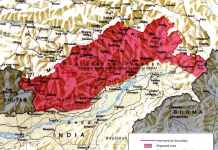Can we expect winds of change in Eastern Ladakh – the flashpoint between India and China – in the coming days? Hard to say, but the situation could marginally improve given a series of developments in the past few days.
Will Joe Biden Poke His Nose Into The Kashmir Issue & Complicate Matters Between India & Pakistan?
The Indian Army has handed over a Chinese soldier who transgressed across the Line of Actual Control, to the People’s Liberation Army. For a change, Chinese experts have hailed this move, by saying, “India showed goodwill in de-escalating the border tension by returning the Chinese soldier within four days,” the state-owned Global Times says.
Earlier, the Indian Army said that in the early hours of January 8, a Chinese soldier was apprehended on the Indian side of the LAC, in Ladakh, in an area South of Pangong Tso.
“The PLA soldier had transgressed across the LAC and was taken into custody by Indian troops deployed in this area…The PLA soldier is being dealt with as per laid down procedures and circumstances under which he had crossed the LAC are being investigated,” the Army had said in a statement.
There is a border regulation mechanism between China and India, and the move to return the PLA soldier was in accordance with that norm. Of course, this was not a one-of-its-kind incident. Even in October last year, the Indian Army had returned a PLA corporal who was apprehended after he strayed into the Indian territory.
Similarly, the Chinese PLA had handed over five youths from Arunachal Pradesh who accidentally crossed the LAC to the Chinese side, to India in September.

Reduction of troops along LAC?
If media reports are to be believed, the two countries are gradually reducing their troops from the border region. The Times of India very specifically says that China has de-inducted nearly 10,000 soldiers from places, 200 km from the LAC, but India apparently effected a “minor reduction”.
But the operational situation remains grim on key points such as Pangong Tso, Chusul, Depsang Plains among others primarily because of the element of distrust that has taken root in the Indian psyche after the 2017 Doklam standoff. Satellite images reveal how China has set up a full-fledged village in an area close to the site where the PLA had a face-off with the Indian Army.
India would definitely tread cautiously this time. De-escalation is possible only when both sides reach a consensus and China sticks to the agreement and implement all measures in letter and spirit.
But it’s easier said than done as President Xi Jinping has made a clarion call to the PLA to be combat-ready. As reported by The EurAsian Times, Xi who heads the powerful Central Military Commission has managed to consolidate power in his hands by tweaking the national defense policy.
An Unpredictable Neighbor
India’s predicament is that it has to deal with an unpredictable neighbor. Ever since India’s independence, it has faced Chinese aggression in one form or the other with the climax reaching in 1962 that resulted in a bloody war. New Delhi’s failure to come out with a China-specific foreign policy over the years has proved to be its biggest impediment.
While Communist China’s growing assertiveness in South Asia and the Asia Pacific is widely acknowledged, India as a powerful democracy has not been able to capitalize on the concerns of the like-minded countries.
Understandably, nations across the globe are now busy tackling the Covid-19 pandemic and mending their economies. However, this could also be a golden opportunity for New Delhi to frame a multi-pronged reach-out policy vis-à-vis entire Asia.
To do this, New Delhi has to recalibrate its ‘Neighborhood-First’ policy to cover defense and economic ties. And there’s no time to waste. Starting from its next-door neighbors of Bangladesh, Nepal, Bhutan, Myanmar, Sri Lanka, Maldives, it should get closer to Vietnam, Indonesia, the Philippines that have locked horns with China over maritime territories. Time is ripe, India needs to just sow the seeds.
Follow EurAsian Times on Google News




